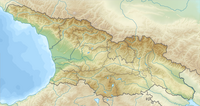Tetrizkaro (Georgian: თეთრიწყარო, engl. Spelling Tetritskaro) is a district capital in the region Kwemo Kartli. There are numerous historical sights around the small spa town, including the historic town of Samschwilde, the Pitareti church and the medieval fortress of Birtwissi. Also the Caucasus-German settlement Assureti is located in the administrative district.
 | ||
| თეთრიწყარო, Tetrizkaro, Tetritskaro | ||
| Region (Mchare) | Kwemo Kartli | |
|---|---|---|
| Residents | 3800 | |
| other value for residents on Wikidata: 3093 | ||
| height | 1,180 m | |
| no tourist info on Wikidata: | ||
| location | ||
| ||
background
The name Tetrizkaro translated in German means "White Fountain" or "White Spring".
getting there
From Tbilisi, minibuses run from the Isani bus station to Tetritskaro, and marshrutkas are also available from neighboring cities.
Tetrizkaro is about 50 kilometers by road from Tbilisi away. Follow the trunk road ს 6 ri. Marneuli to Koda, there you turn right onto the very well developed regional road შ 34 ri. Zalka and in the village of Parzchissi to the left (continue to შ 34). This regional road is well developed as far as Tetrizkaro, but after Tetrizkaro it is unpaved via a steep serpentine road to Zalka.
The regional road შ 33 to Marneuli is well developed, the regional road შ 35 to Bolnissi is in poor condition and from Samschwilde can only be accessed with off-road vehicles.
The Tbilisi railway runs a few kilometers south of the city.Akhalkalakiwhich currently has no passenger traffic. She will be until 2015[outdated] renewed and will then become part of the Tbilisi railwayKars be.
mobility
With cars, taxis and marshrutkas in the area, for back roads, an off-road vehicle is advantageous.
Tourist Attractions
Tetrizkaro is a small spa town with a few dachas and a nice spa park at the east end of the city, where you can also find a statue of Stalin. In the vicinity there are also the historic churches of Gudarechi and Pitareti, which are worth seeing, as well as the historic town of Samschwilde and the former Caucasian German settlement Assureti (Elisabeth Valley).
Samschwilde
.jpg/220px-Samshvilde_fortress_(Photo_A._Muhranoff,_2010).jpg)
Samschwilde (Georgian: სამშვილდე) is one of the oldest fortified cities in the region. Investigations on the ruins and a burial ground showed that the city was laid out in the early phase of the early Bronze Age Mtkvari-Araxis culture (2nd half of the 4th millennium BC). In the ruins there are numerous pre-Christian places of worship as well as stone circles and menhirs.
The ruins of Samschwilde are located a few kilometers south of the modern village of the same name, 5 km south of Tetrizkaro, the access road is only accessible with off-road vehicles.
Weblink: [1]
Gudarechi
.jpg/220px-Gudarekhi_monastery_(Photo_A._Muhranoff,_2011).jpg)
The village of Gudarechi is located about 10 km northeast of Tetrizkaro. During archaeological excavations in 1938/39, based on the developed pottery, it was found that there are ruins of a medieval settlement here. The complex includes the remains of a palace, apartment buildings, a wine cellar and other structures that date back to the 12th-16th centuries. Century.
South of the excavations is a single-nave church with a free-standing two-story bell tower (13th century). This was built by the architect Tschitschaporisidze in the 13th century. The facade decoration consists of studded, richly relief stones. The icons and frescoes of the church are now in the Art Museum in Tbilisi. The monastery was renovated in 2006.
Pitareti

The Georgian Orthodox Pitareti Monastery (Georgian: ფიტარეთი) is located in the Kzia Valley, 26 kilometers southwest of Tetrizkaro. The Pitareti Monastery consists of the Theotokos Church, the bell tower, the ruined wall and several smaller monastic buildings. The main church of the monastery was built at the beginning of the 13th century by the Georgian King Giorgi IV. Lascha. The shape corresponds to today's canon of a Georgian domed church. The church of the Pitareti monastery is stylistically similar to the churches from the 12th-13th centuries. Century how Betania, Kwatachewi and Timotessubani. The facades are decorated with ornaments and accented with niches and dormers. The entire interior of the church was once decorated with frescoes, of which only fragments remain today.
The access to Pitareti can be from Tetrizkaro as well as from Bolnissi respectively:
- From Tetrizkaro you drive a gravel road to the village of Alekseevka, from a sign you go off-road across the green meadow. Soon you can only continue on foot, but from the signpost "Pitareti 4 km" it is almost 14 km to walk.
- From Bolnissi you drive west and in Kweschi turn onto the regional road to Tandsia, where the asphalt road ends. There is a small, easy to miss, signpost to Pitareti, 7 km. After a few meters of gravel road you have to go straight at the fork in the road, over a steep serpentine road 4 km to the river. There you cross a swaying pedestrian bridge - which, however, was not usable as of autumn 2013 - and after another 3 km walk you reach the monastery.
activities
- Hiking and climbing in Birtwissi
- Unfortunately, the Algeti reservoir (also known as the Tbisi reservoir) is not suitable for swimming
shop
kitchen
accommodation
A large selection of hotels of all kinds can be found in Tbilisi.
health
Practical advice
trips
- Birtwissi. Extensive medieval fortress and narrow canyons.
- Manglissi
- Zalka
- Bolnissi. Former Katharinenfeld; significant settlement of the Caucasus Germans.
- Assureti. Former Elisabeth Valley; Another important settlement of the Caucasus Germans in the region, where you can still admire old German half-timbered houses.

